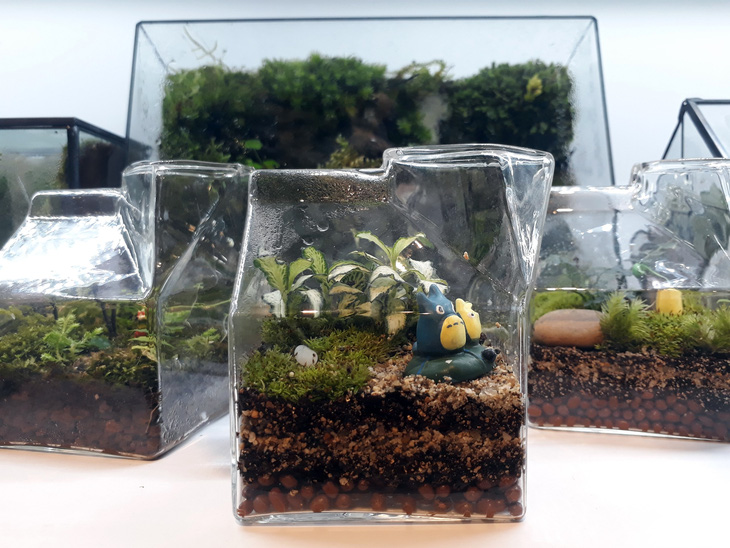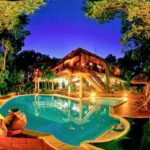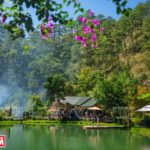A terrarium is typically a sealable glass container with soil and plants inside. They are created in such a way that the glass container essentially houses its own ecosystem.
Dang Van Thanh, a 25-year-old resident of Linh Trung Ward, Thu Duc City, Ho Chi Minh City, recently finished his first homemade terrarium after spending a month following tutorials from the internet.
An ecosystem in your palm
Thanh’s terrarium is 15 centimeters long, 15 centimeters wide, and 20 centimeters tall. Inside sits a replica Japanese pagoda tucked away against a miniature rocky cliff.
At the entrance to the pagoda is a torii – a Japanese style gate – that Thanh hand-carved from small wooden planks.
|
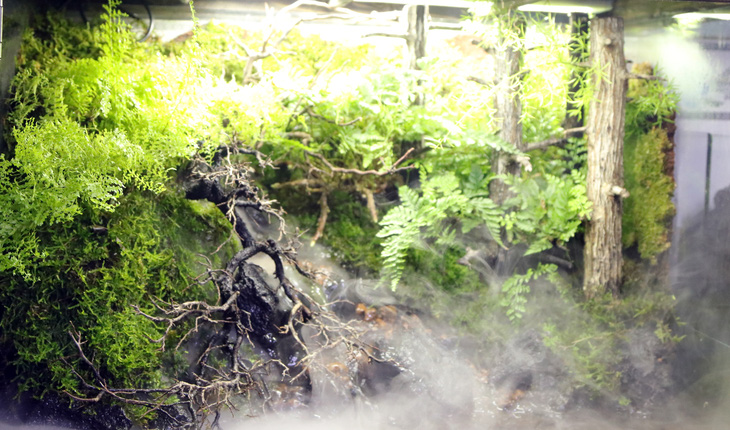
|
| A terrarium is often a self-sustaining ecosystem. |
The roof of the pagoda was made using plastic and stone powder. The path leading to the pagoda is lined with pebbles while the green moss, grass, and plants that surround the pagoda create a jungle-like atmosphere.
Thanh first fell in love with the idea of designing his own terrarium about a year ago, but it took him several months before he finally got around to making one.
His first stem involved laying lava stone at the base of the glass enclosure, followed by gravel, white pebbles, soil, and an Akadama tree.
To transform the terrarium into a sustainable ecosystem, Thanh planted ferns, velvet moss, and other plants.
By closing off the terrarium with a lid, Thanh has created a self-sustaining ecosystem that relies on water evaporation and condensation to maintain life.
Terrariums should be kept in bright areas. They come in different sizes, with some small enough to fit in the palm of a hand and others measuring several meters across.
“[Building terrariums] is way more exciting than growing plant pots and hanging them on the balcony,” said Thanh.
“With terrariums, you can see the interaction of the greenery and how the elements inside depend on one another for growth. They mimic real nature.”
Follow your creativity
Because terrariums can be difficult to make, several businesses have popped up to help would-be enthusiasts get started with kits that contain cardboard boxes, soil, sand, plants, knives, tweezers, and buckets.
|
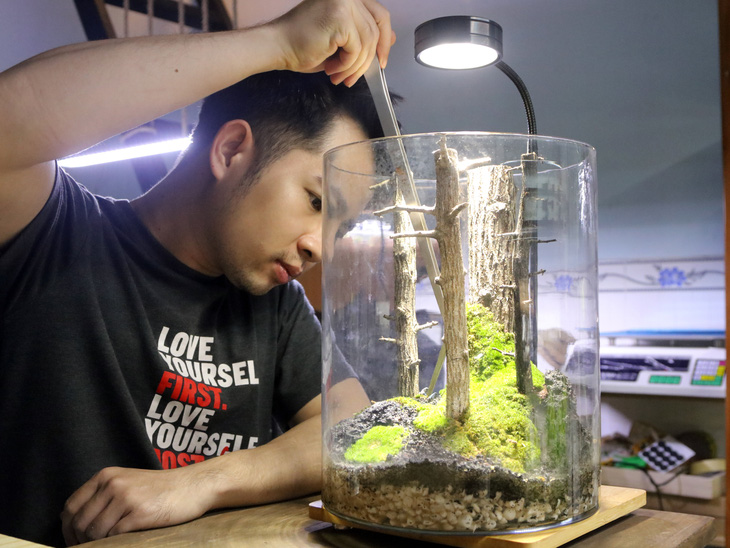
|
| A terrarium maker finalizes his design using specialized tools. |
The Terrator – a terrarium design hub in Phu Nhuan District, Ho Chi Minh City offers terrarium workshops for VND780,000 (US$37.20).
These workshops teach learners the fundamentals of terrarium making and give participants the opportunities to create their own.
“Everyone has their own individual perspective, so every terrarium is different,” said a representative from The Terrator.
In order to help terrarium newbies bring their visions to life, some experienced terrarium makers offer one-on-one lessons.
Eun Joo Jang, a 38-year-old resident of Binh Hung Tay Ward, Thu Duc City, yearns to visit the broadleaf forests of western Europe.
She pictures herself seated quietly on a train, traveling through tunnels and past crystal clear lakes flanked by greenery.
Though Jang may not be able to go to visit a western European forest, she can bring the forest to Vietnam.
Together with a private tutor, she has been spending her time sketching out her vision, preparing materials, carving, gluing, creating mountains, drilling caves, and digging ponds inside a terrarium.
|
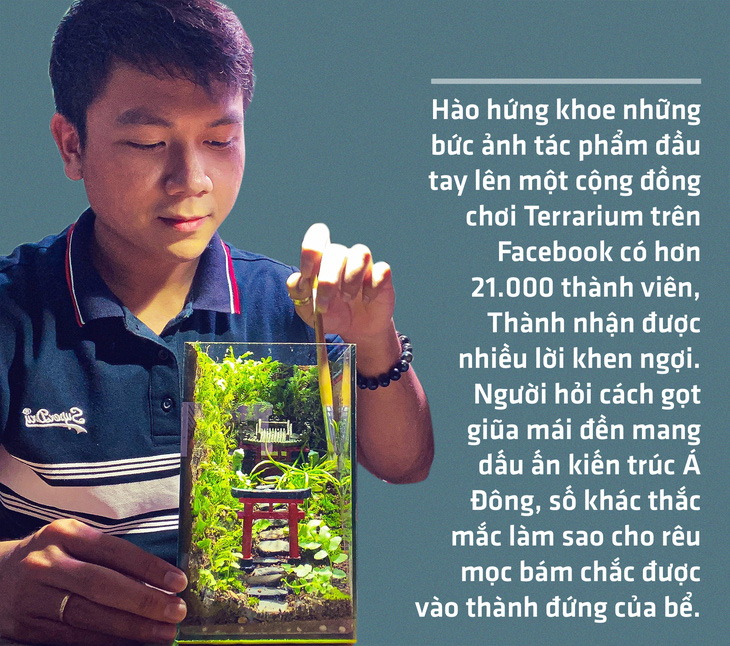
|
| Dang Van Thanh, a newbie in Vietnam’s terrarium community, has received loads of compliments after posting about his handmade terrarium on Facebook. |
In total, Jang spent just VND2 million ($83.84) and wound up with the terrarium of her dreams.
“Every day when I wake up, the first thing I do is check on my terrarium,” said Jang.
“After work, I water the plants. It really helps me relieve my stress.
“Over time, it has truly transformed into an ecosystem. First, a few worms moved in, then a family of spiders, and now other insects. My dream is now a reality.”
Nguyen Hoang Phong, a 28-year-old resident of District 7, uses his terrarium as a tool to balance his spirit and take his imagination on an adventure beyond his room.
When Phong wants to travel, he creates a terrarium in the likeness of the place he wants to travel.
“Creating terrariums is a passion. You have to love them and be open to nature,” said Phong.
“An angry person cannot put together a soulful product. You need to slow down, contemplate what you are doing, and allow your soul to be nurtured,” he explained.
A supportive community
It is not particularly difficult to find the materials needed to create a terrarium, with stores across Ho Chi Minh city selling many of the needed materials.
For the tank, most makers opt for cylinder, pentagonal, or octagonal glass enclosures. Others go for tanks that resemble houses, boats, treasure chests, and other designs.
The most important thing is the owner’s understanding of the plants they have,” said Phong.
“They should know whether their plants are built for humid weather, dry weather or dim lighting so that they can be placed together to make the best terrarium.”
|
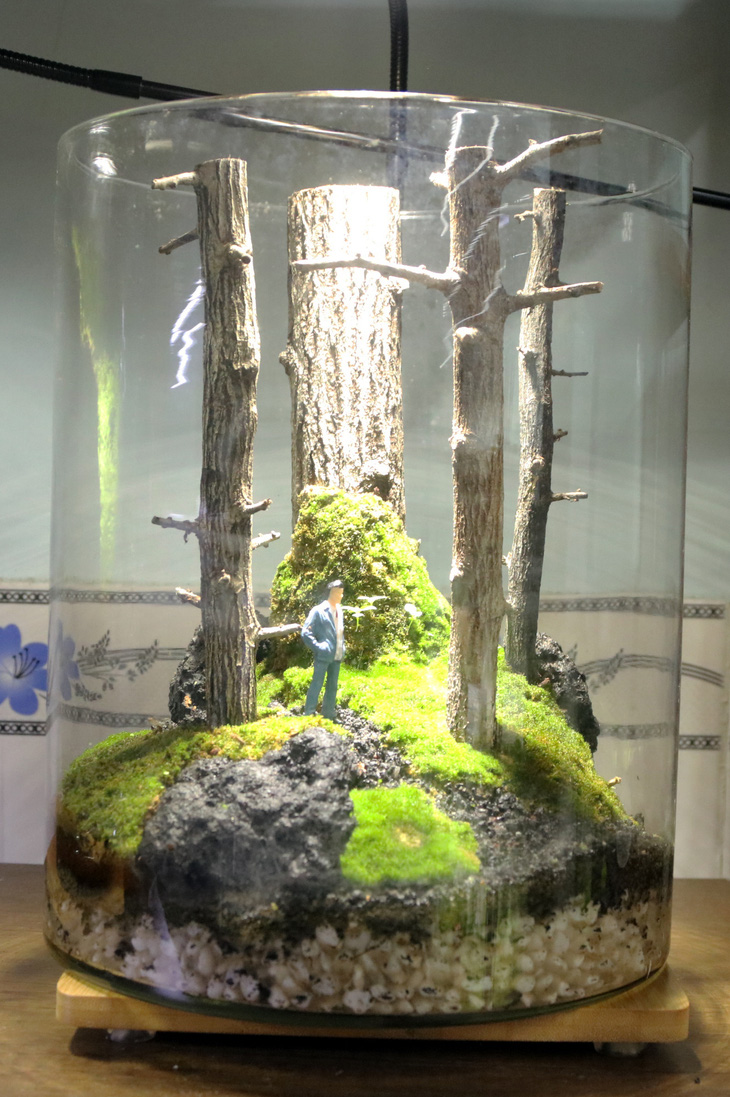
|
| Some terrariums are closed, relying on evaporation and condensation to sustain life. |
|
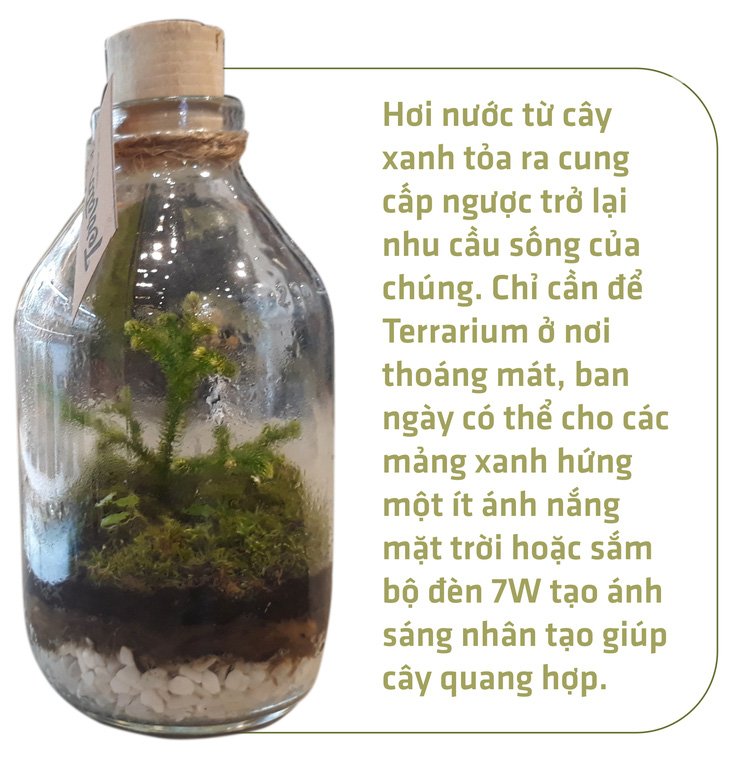
|
| The actualizations of terrariums differ from person to person, depending on their individual divisions. |
Like us on Facebook or follow us on Twitter to get the latest news about Vietnam!
Plant lovers across Vietnam are creating their own miniature gardens, allowing them to relieve stress and connect with nature.
A terrarium is typically a sealable glass container with soil and plants inside. They are created in such a way that the glass container essentially houses its own ecosystem.
Dang Van Thanh, a 25-year-old resident of Linh Trung Ward, Thu Duc City, Ho Chi Minh City, recently finished his first homemade terrarium after spending a month following tutorials from the internet.
An ecosystem in your palm
Thanh’s terrarium is 15 centimeters long, 15 centimeters wide, and 20 centimeters tall. Inside sits a replica Japanese pagoda tucked away against a miniature rocky cliff.
At the entrance to the pagoda is a torii – a Japanese style gate – that Thanh hand-carved from small wooden planks.
|

|
| A terrarium is often a self-sustaining ecosystem. |
The roof of the pagoda was made using plastic and stone powder. The path leading to the pagoda is lined with pebbles while the green moss, grass, and plants that surround the pagoda create a jungle-like atmosphere.
Thanh first fell in love with the idea of designing his own terrarium about a year ago, but it took him several months before he finally got around to making one.
His first stem involved laying lava stone at the base of the glass enclosure, followed by gravel, white pebbles, soil, and an Akadama tree.
To transform the terrarium into a sustainable ecosystem, Thanh planted ferns, velvet moss, and other plants.
By closing off the terrarium with a lid, Thanh has created a self-sustaining ecosystem that relies on water evaporation and condensation to maintain life.
Terrariums should be kept in bright areas. They come in different sizes, with some small enough to fit in the palm of a hand and others measuring several meters across.
“[Building terrariums] is way more exciting than growing plant pots and hanging them on the balcony,” said Thanh.
“With terrariums, you can see the interaction of the greenery and how the elements inside depend on one another for growth. They mimic real nature.”
Follow your creativity
Because terrariums can be difficult to make, several businesses have popped up to help would-be enthusiasts get started with kits that contain cardboard boxes, soil, sand, plants, knives, tweezers, and buckets.
|

|
| A terrarium maker finalizes his design using specialized tools. |
The Terrator – a terrarium design hub in Phu Nhuan District, Ho Chi Minh City offers terrarium workshops for VND780,000 (US$37.20).
These workshops teach learners the fundamentals of terrarium making and give participants the opportunities to create their own.
“Everyone has their own individual perspective, so every terrarium is different,” said a representative from The Terrator.
In order to help terrarium newbies bring their visions to life, some experienced terrarium makers offer one-on-one lessons.
Eun Joo Jang, a 38-year-old resident of Binh Hung Tay Ward, Thu Duc City, yearns to visit the broadleaf forests of western Europe.
She pictures herself seated quietly on a train, traveling through tunnels and past crystal clear lakes flanked by greenery.
Though Jang may not be able to go to visit a western European forest, she can bring the forest to Vietnam.
Together with a private tutor, she has been spending her time sketching out her vision, preparing materials, carving, gluing, creating mountains, drilling caves, and digging ponds inside a terrarium.
|

|
| Dang Van Thanh, a newbie in Vietnam’s terrarium community, has received loads of compliments after posting about his handmade terrarium on Facebook. |
In total, Jang spent just VND2 million ($83.84) and wound up with the terrarium of her dreams.
“Every day when I wake up, the first thing I do is check on my terrarium,” said Jang.
“After work, I water the plants. It really helps me relieve my stress.
“Over time, it has truly transformed into an ecosystem. First, a few worms moved in, then a family of spiders, and now other insects. My dream is now a reality.”
Nguyen Hoang Phong, a 28-year-old resident of District 7, uses his terrarium as a tool to balance his spirit and take his imagination on an adventure beyond his room.
When Phong wants to travel, he creates a terrarium in the likeness of the place he wants to travel.
“Creating terrariums is a passion. You have to love them and be open to nature,” said Phong.
“An angry person cannot put together a soulful product. You need to slow down, contemplate what you are doing, and allow your soul to be nurtured,” he explained.
A supportive community
It is not particularly difficult to find the materials needed to create a terrarium, with stores across Ho Chi Minh city selling many of the needed materials.
For the tank, most makers opt for cylinder, pentagonal, or octagonal glass enclosures. Others go for tanks that resemble houses, boats, treasure chests, and other designs.
The most important thing is the owner’s understanding of the plants they have,” said Phong.
“They should know whether their plants are built for humid weather, dry weather or dim lighting so that they can be placed together to make the best terrarium.”
|

|
| Some terrariums are closed, relying on evaporation and condensation to sustain life. |
|

|
| The actualizations of terrariums differ from person to person, depending on their individual divisions. |
Like us on Facebook or follow us on Twitter to get the latest news about Vietnam!
Surrounded by rivers, Vam Sat Mangrove Forest Eco-Tourist Site in the Can Gio Biosphere Reserve has the most beautiful forests. It has been recognized by the United Nations World Tourism Organization (UNWTO) as one of the world’s eco-tourist sites with sustainable development in Vietnam.
Visiting Vit Co Xanh Eco-Tourism Area in Cu Yen Commune, Luong Son District, Hoa Binh Province, 45km from Hanoi, tourists will have a wonderful time of total relaxation in a peaceful green space and learn about the cultural features of the Muong ethnic people.
NDO – The fifth Vietnam Heritage Photo Contest, themed ‘Vietnamese rivers’, was officially launched by the Vietnam Heritage Magazine in Ho Chi Minh City on August 2.
NDO – The seventh Vietnam Heritage Photo Contest 2018, was officially launched by the Vietnam Heritage Magazine under the Vietnam Cultural Heritage Association, in Ho Chi Minh City on August 1.
Located deep inside the Da Nghit forest of Lac Duong District (Lam Dong Province), Ma Rung Lu Quan (Forest Ghost Inn) is an intriguing stopover for nature-enthusiastic travellers on their journey to explore the Central Highlands.

